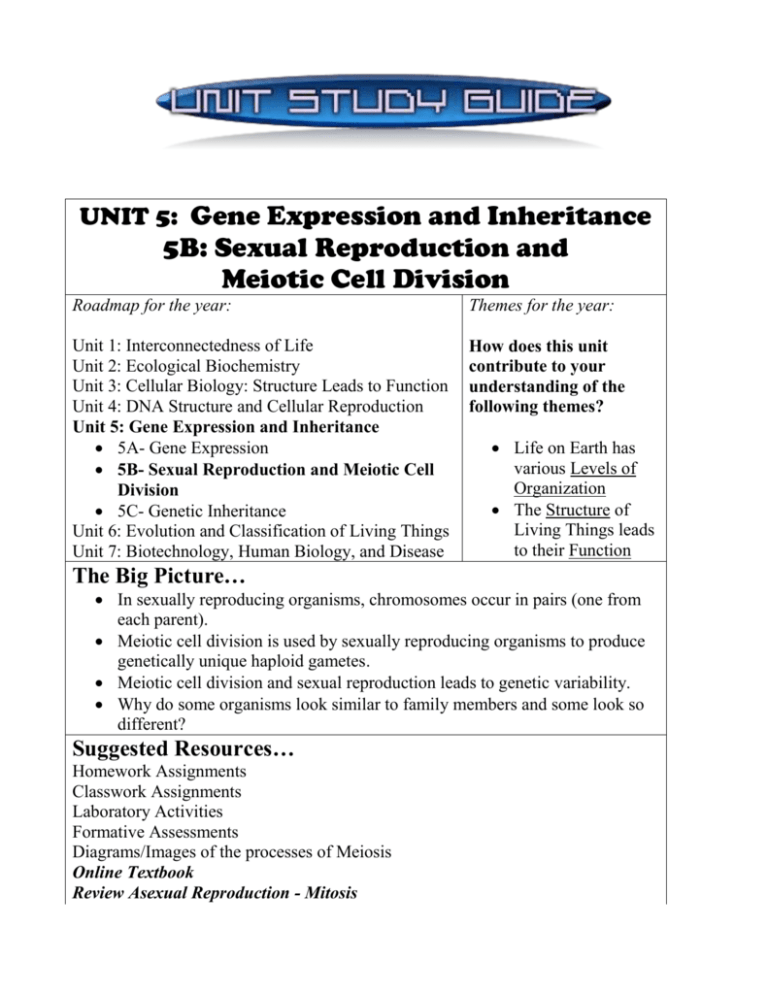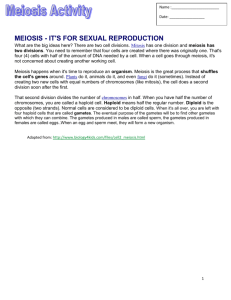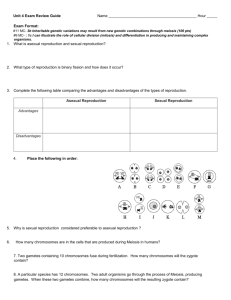5B- Sexual Reproduction and Meiotic Cell Division
advertisement

UNIT 5: Gene Expression and Inheritance 5B: Sexual Reproduction and Meiotic Cell Division Roadmap for the year: Themes for the year: Unit 1: Interconnectedness of Life Unit 2: Ecological Biochemistry Unit 3: Cellular Biology: Structure Leads to Function Unit 4: DNA Structure and Cellular Reproduction Unit 5: Gene Expression and Inheritance 5A- Gene Expression 5B- Sexual Reproduction and Meiotic Cell Division 5C- Genetic Inheritance Unit 6: Evolution and Classification of Living Things Unit 7: Biotechnology, Human Biology, and Disease How does this unit contribute to your understanding of the following themes? The Big Picture… Life on Earth has various Levels of Organization The Structure of Living Things leads to their Function In sexually reproducing organisms, chromosomes occur in pairs (one from each parent). Meiotic cell division is used by sexually reproducing organisms to produce genetically unique haploid gametes. Meiotic cell division and sexual reproduction leads to genetic variability. Why do some organisms look similar to family members and some look so different? Suggested Resources… Homework Assignments Classwork Assignments Laboratory Activities Formative Assessments Diagrams/Images of the processes of Meiosis Online Textbook Review Asexual Reproduction - Mitosis By the conclusion of this unit, you should know the following: Meiosis occurs in sexually reproducing organisms in two discrete phases (Meiosis I and Meiosis II), culminating in the creation of genetically unique haploid gametes. Meiosis is often called ‘reduction division’. During meiosis I a diploid number of double-armed chromosomes is reduced to a haploid number of doublearmed chromosomes. During meiosis II that is then reduced to a haploid number of single-armed chromosomes. Crossing over, independent assortment & random fertilization of unique gametes all contribute to variability within a species. In sexually reproducing organisms, diploid parents produce haploid gametes (through meiotic cell division) which then restore the diploid number upon fertilization; the new diploid organism then grows by mitotic cell division. Spermatogenesis occurs in male testes to create 4 functional sperm cell per meiotic cycle. Oogenesis occurs in female ovaries to create 1 functional egg cell (and 3 polar bodies) per meiotic cycle. Nondisjunction is one example of an error that can occur during meiosis wherein chromosomes do not divide properly, resulting in the creation of abnormal gametes. Fertilization using abnormal gamete(s) generally leads to abnormal or nonviable zygotes. A karyotype is a picture formed by arranging homologous chromosomes according to their size; this chart can be used to check for chromosomal abnormalities. By the conclusion of this unit, you should be able to do the following: Compare and contrast the effect of mutations in somatic cells vs. sex cells. Compare and contrast sexual and asexual reproduction. Apply the understanding of normal meiosis to problems that may occur during gamete formation. Realize that there are three main processes (crossing over, independent assortment, and random fertilization of unique gametes) that contribute to genetic variability of a sexually reproducing species. Compare and contrast mitosis, meiosis I and meiosis II. Justify the name, ‘reduction division’ for meiosis by explaining how haploid gametes are created from a diploid parental body cell. Explain how meiotic and mitotic cell division are both necessary to give rise to successive generations of sexually reproducing organisms. Compare and contrast spermatogenesis and oogenesis. Explain what a karyotype is and how it is generated. Recognize the presence and possible origin of chromosomal abnormalities in a human karyotype. Sexual Reproduction and Meiotic Cell Division Vocabulary Words Found in the Glossary 1) Centromere: 2) Diploid: 3) Haploid: 4) Gamete: 5) Zygote: 6) Asexual Reproduction: 7) Sexual Reproduction: 8) Homologous (Chromosomes): 9) Karyotype: 10) Mitosis: 11) Meiosis: 12) Fertilization: 13) Interphase: 14) Prophase: 15) Metaphase: 16) Anaphase: 17) Telophase: 18) Cytokinesis: 19) Crossing-over: 20) Independent Assortment: 21) Nondisjunction: Words NOT Found in the Glossary (but may be within the textbook) 22) Double Arm Chromosome: 23) Single Arm Chromosome: 24) Somatic Cell: 25) Egg: 26) Sperm: 27) Reduction Division: 28) Gametogenesis: 29) Oogenesis:








